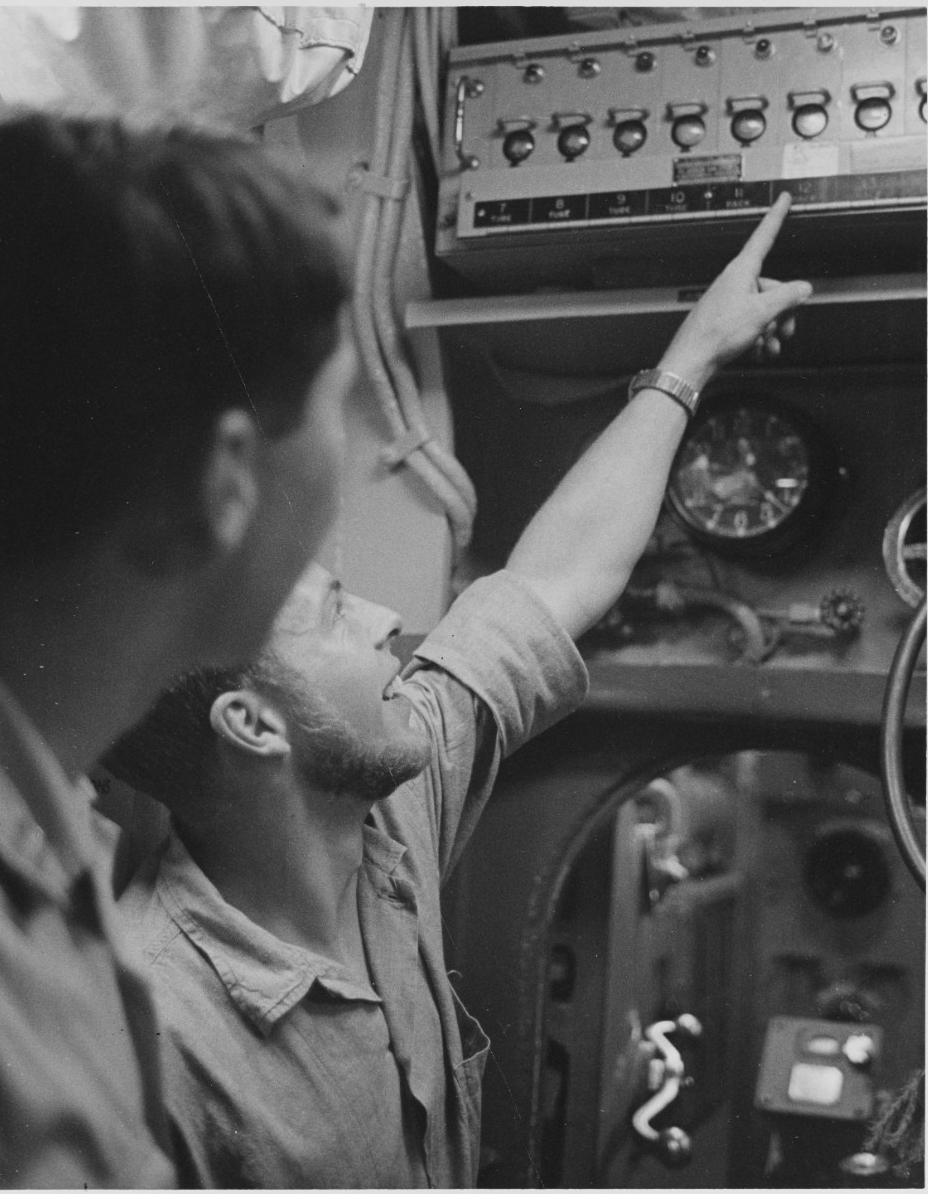Submarine Warfare Insignia (Dolphins)
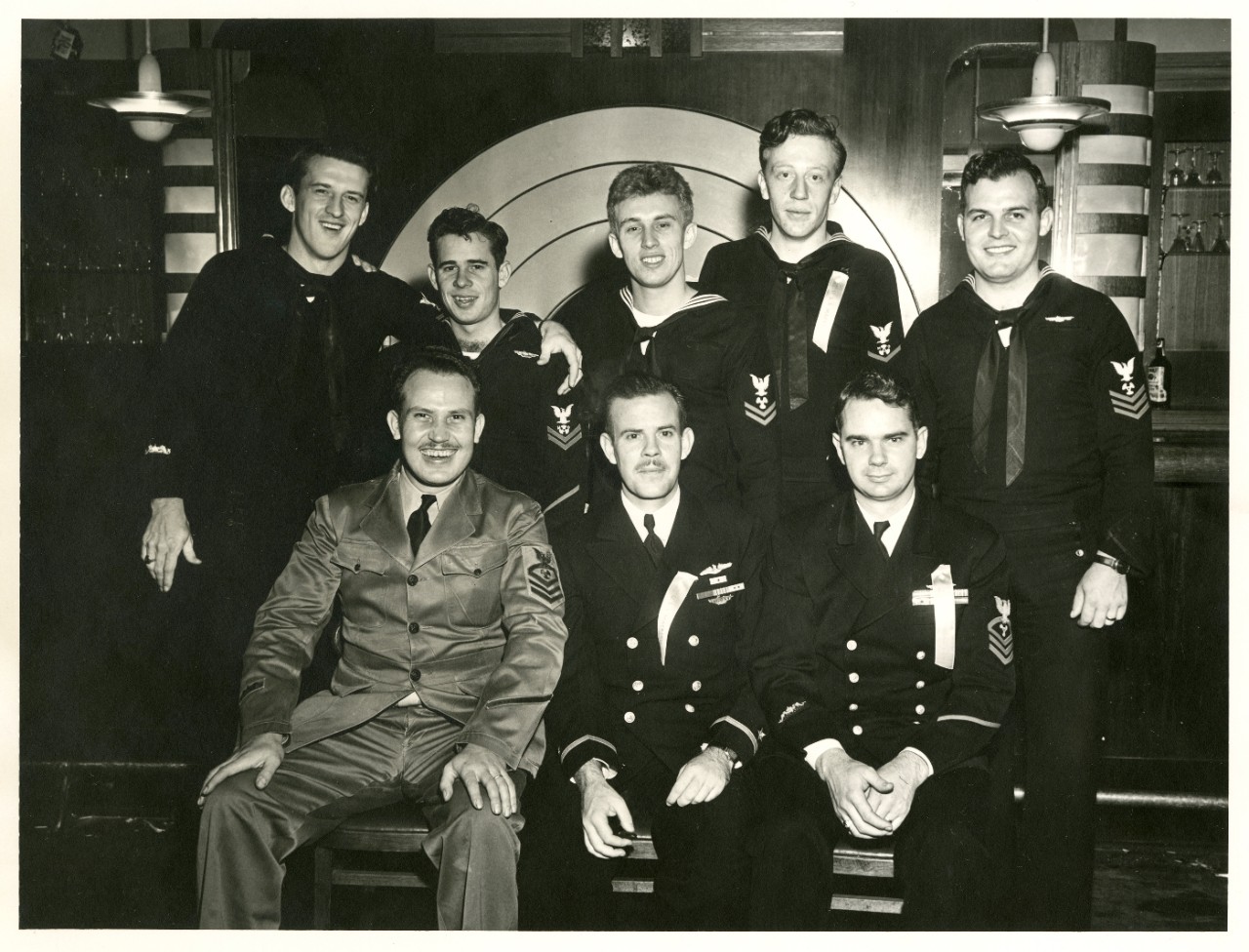
Pictured are crew members of the submarine USS Mackerel (SS-204). It is estimated this photo was taken between October 1944 and December 1945. Ensign Jack Junkin, a former machinist mate first class, is seated in the front row, second from left. Note the “dolphins” pin on his left breast. Some of the enlisted sailors have the dolphins embroidered on their right sleeves. Some are also wearing the Combat Patrol pin, which the Navy awarded to members of the U.S. submarine force during World War II for service on a submarine that sank an enemy ship or performed a comparable combat mission. Gold stars were added for each successful patrol; a silver star would represent five successful patrols. (Photo courtesy of U.S. Naval Undersea Museum)
In the summer of 1923, while serving as Commander, Submarine Division Three, Captain Ernest J. King proposed that the Navy create a warfare insignia device for qualified submariners. The insignia came to be known as “dolphins” or “fish,” and is one of the Navy’s oldest warfare devices. The hard-earned badge distinguishes and identifies the members of the submarine community and has since become a source of pride for the “silent service.”
Not only did King propose the idea for the submarine warfare device, he also submitted the initial design. His drawing, which he submitted to the Bureau of Navigation for consideration, included a shield mounted on the beam ends of a submarine, with dolphins forward and aft of the conning tower. The bureau considered a shark and shield motif as well but ultimately hired a Philadelphia jewelry design firm to create the design.
The final design of the device was approved for wear on 24 March 1924. It displays a bow view of a surfaced O-class submarine with two dolphins resting their heads on the submarine’s bow planes. The dolphins depicted on the insignia are actually dolphinfish, or mahi-mahi, not the marine mammal.
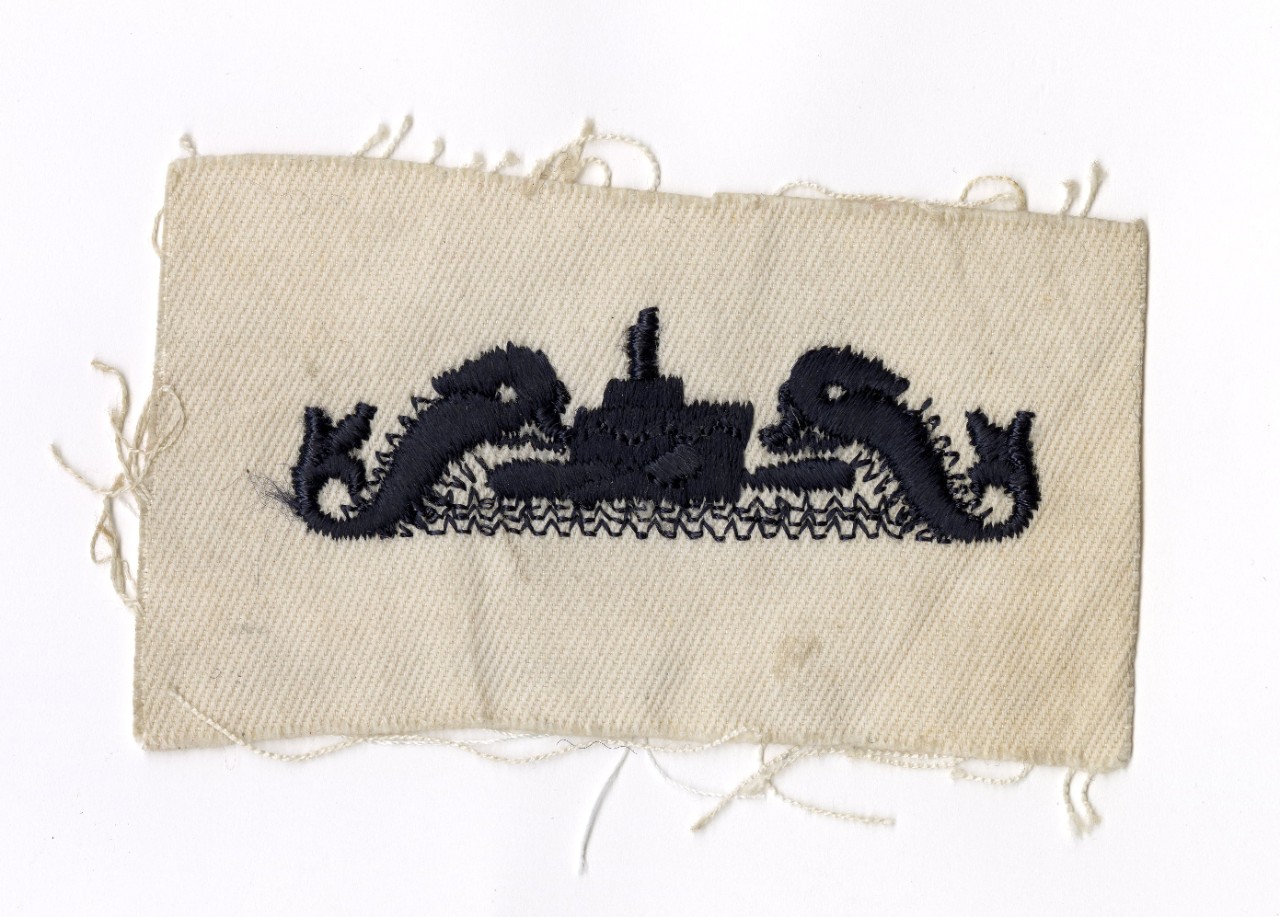
One of the earliest designs of the submarine warfare insignia, circa 1924. Enlisted personnel wore this insignia, embroidered in silk, with white silk for blue clothing and blue silk for white clothing. (Photo courtesy of U.S. Naval Undersea Museum)
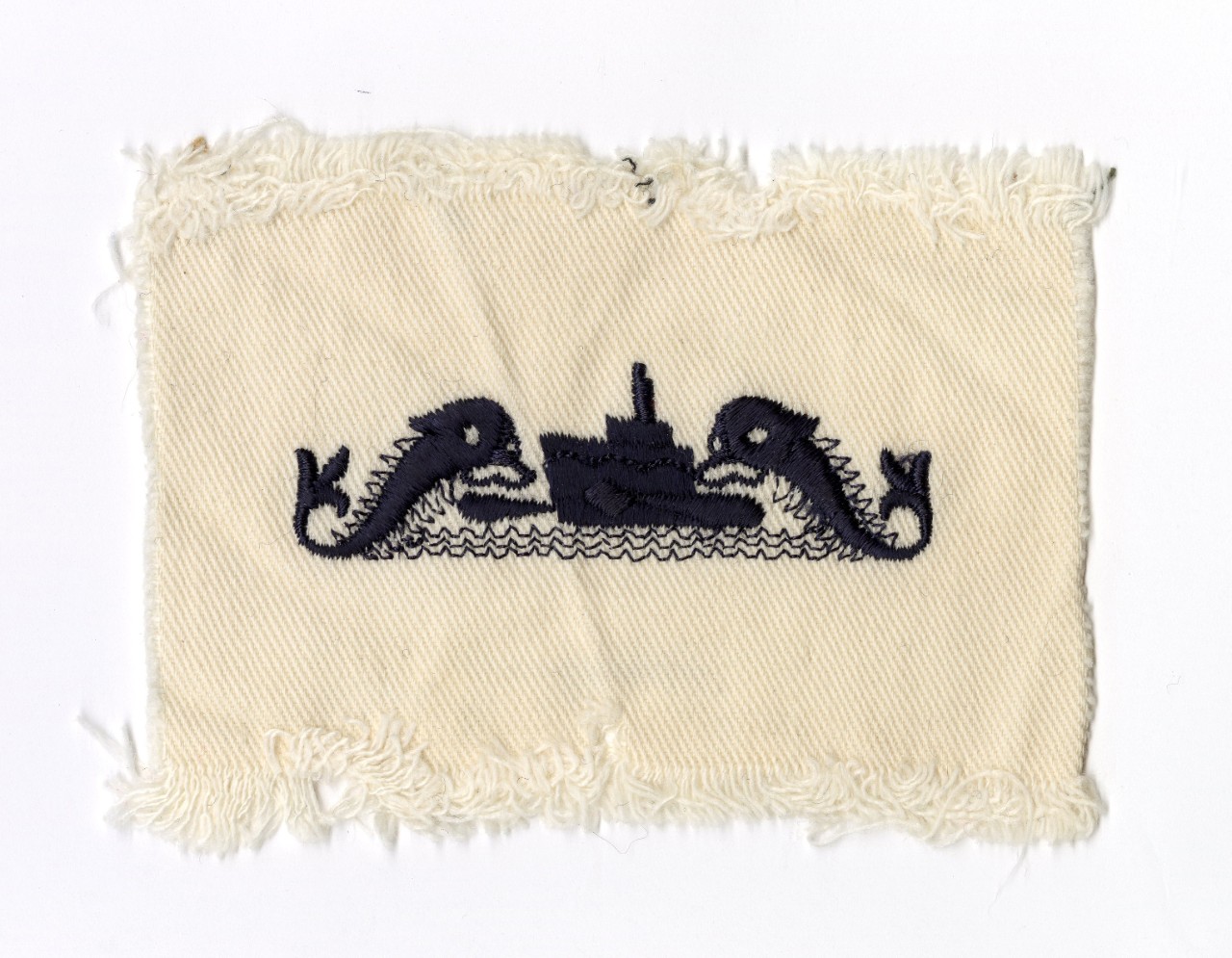
Another example of the early enlisted submarine warfare insignia design, circa 1924. The insignia became official in March 1924 when it was approved by Acting Secretary of the Navy Theodore Roosevelt Jr. It has undergone only minor changes since its introduction. (Photo courtesy of U.S. Naval Undersea Museum)
From 1924–47, qualified enlisted personnel wore an embroidered cloth version of this design on their right sleeve, midway between the wrist and elbow. Officers wore a gold-plated metal pin on their left breast above their ribbons and medals. In 1947, new regulations dictated that enlisted personnel wear the embroidered insignia on their left breast—in the same position as officers. When the Navy began allowing officers to embroider a gold insignia on their uniforms in 1950, enlisted personnel were allowed to wear a silver-plated metal version of the pin.
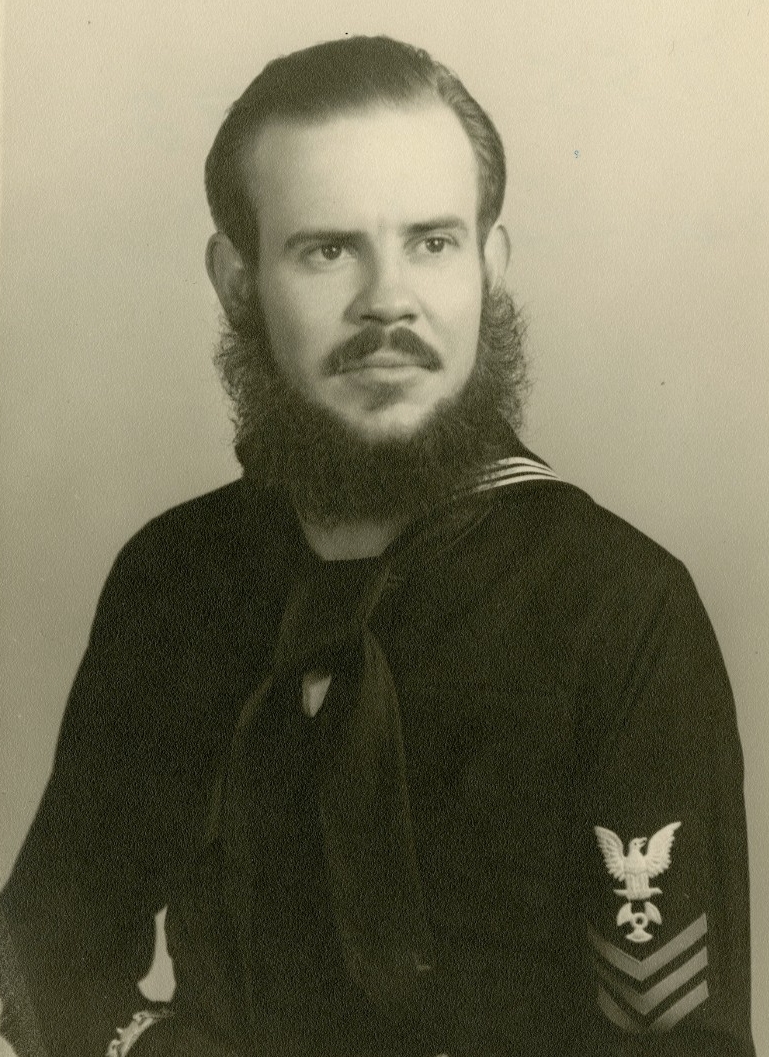
Portrait of MM1 Jack Junkin. Note the silver "dolphins" insignia on his right sleeve. The caption on the back of the photo states that the photo was taken in 1941 at Naval Submarine Base New London when Junkin was assigned to submarine USS S-32 (SS-137). S-32 trained and patrolled in the Panama Canal Zone for part of 1941. The beard indicates he may have just returned from a long patrol and was unable to shave. (Photo courtesy of U.S. Naval Undersea Museum)
Beginning in 1943, the Navy authorized a new design for medical officers in which the submarine motif was replaced by two fish flanking a silver acorn over a gold oak leaf. In 1950, submarine engineering officers were granted their own insignia wherein the submarine motif was replaced by a gold disc inlaid with the letter “E.” The letter was replaced two years later with a ship’s screw. Not to be forgotten, submarine supply officers received their own version of the insignia in 1964 that displayed three oak leaves bordered by acorns.
Submarine personnel also designed their own unofficial insignias specific to their submarine community. Deep-water submarines developed their own insignia as well as nuclear submarine personnel. Submariners with an affinity for diesel boats also created enlisted and officer metal badges emblazoned with the letters “DBF” (diesel boats forever) on the bottom border.
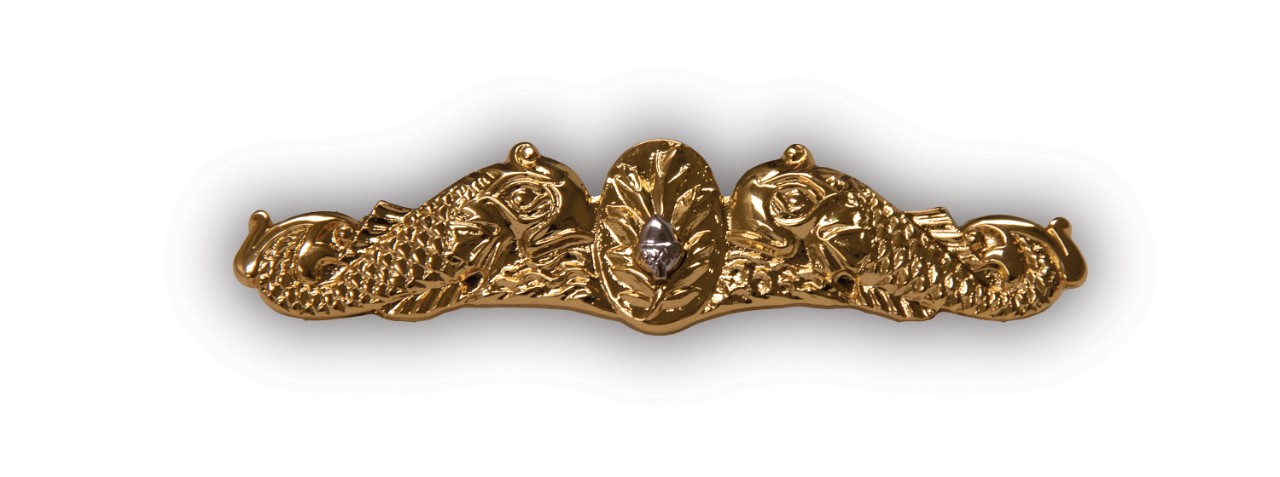
Submarine medical officer "dolphins." (Photo courtesy of U.S. Naval Undersea Museum)
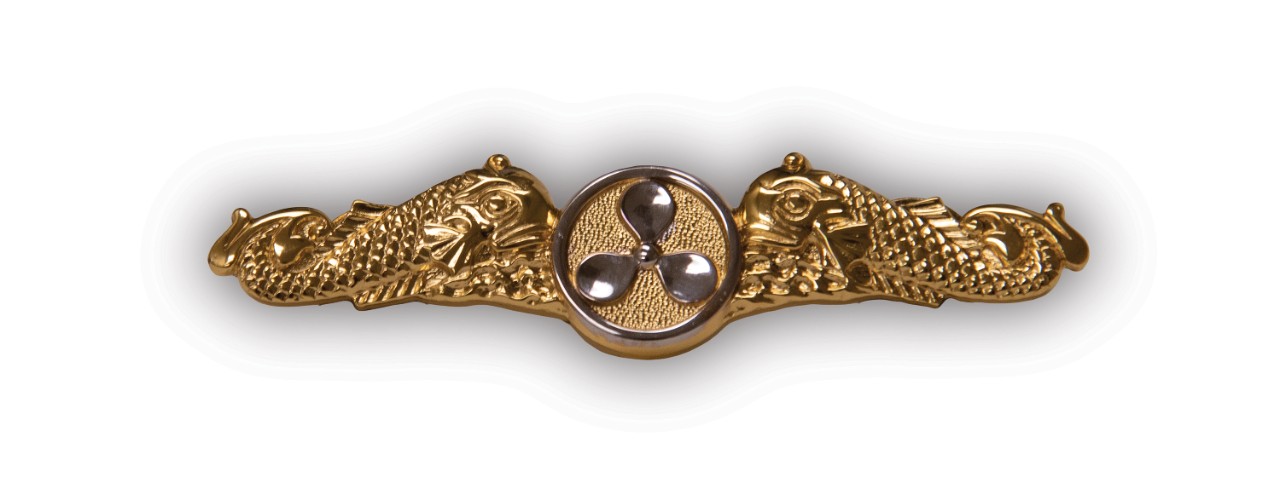
Submarine engineering officer "dolphins." (Photo courtesy of U.S. Naval Undersea Museum)
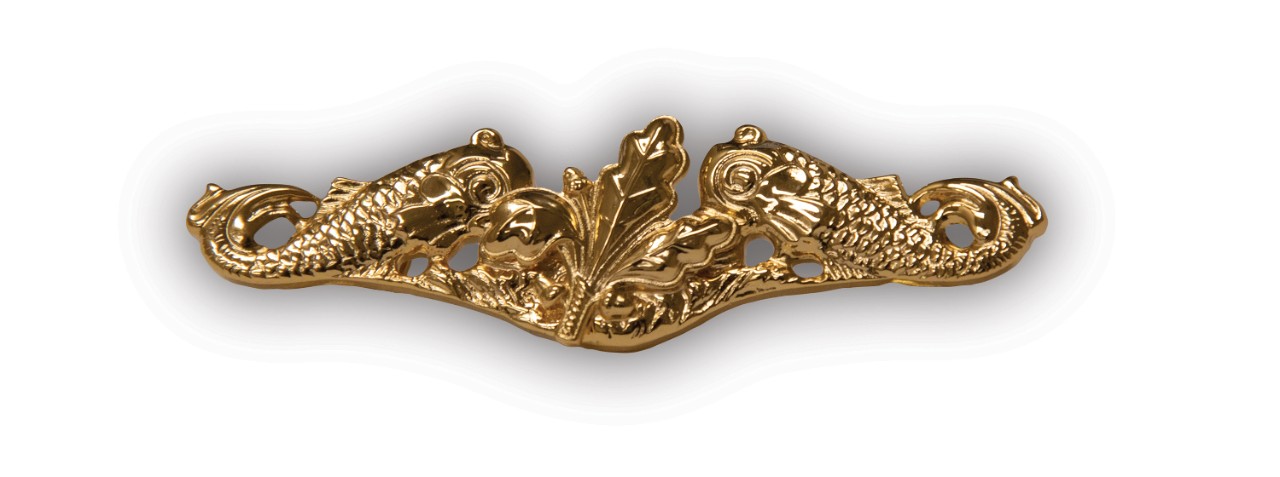
Submarine supply officer "dolphins." (Photo courtesy of U.S. Naval Undersea Museum)
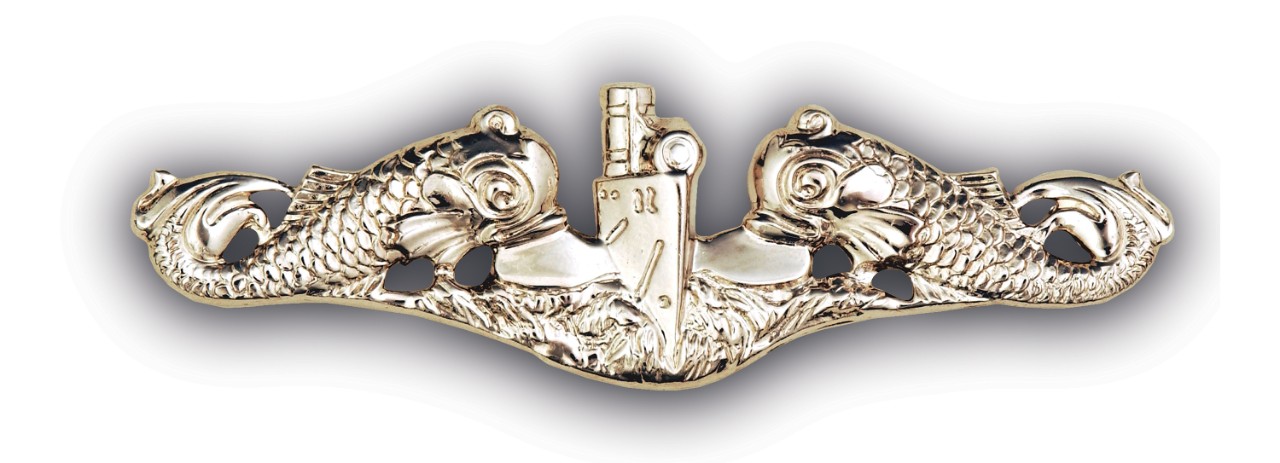
Modern silver "dolphins" worn by enlisted members of the submarine force. (Photo courtesy of U.S. Naval Undersea Museum)
The device, however, is more than just another addition to the uniform. The process of “qualifying” for dolphins on board a submarine is not optional—it’s a requirement for submarine service so that everyone aboard can take immediate action when an emergency occurs. To qualify, sailors must learn everything about a submarine’s systems, operation, and construction. They learn where the damage control gear equipment is located in every compartment, how to plug and patch leaks, extinguish fires, and rig compartments for casualty situations.
The qualification process for officers and enlisted is similar and typically takes a year to complete. Submarine officers and enlisted personnel must demonstrate extensive knowledge of all submarine systems, operations, and compartments as well as damage control, casualty procedures, and watchstanding.
Submariners under instruction complete a qualification card which lists all the submarine systems, compartments, and equipment. Personnel obtain signatures upon receiving proper training and showing understanding of the ship equipment. Upon gaining all their required signatures, they must then pass an oral board. Upon transferring to a new class of submarine, sailors must requalify on the new submarine.
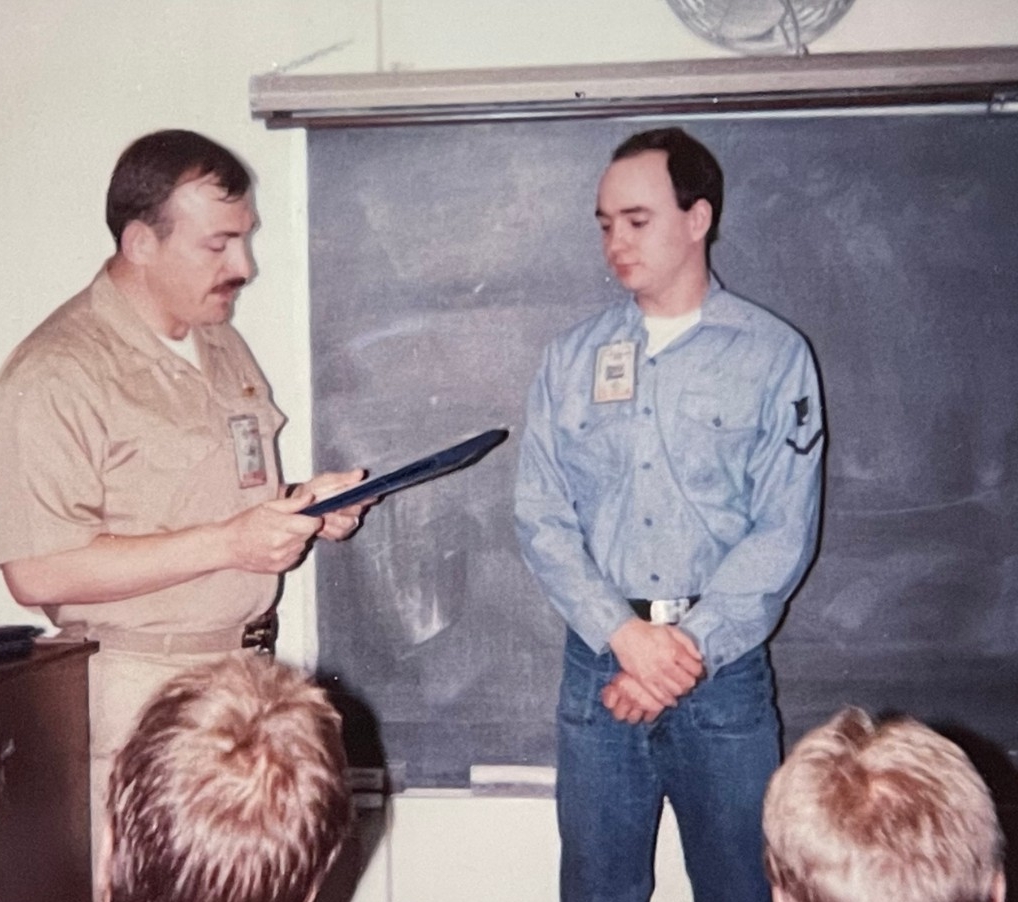
The executive officer of Bluefish (SSN-675) reads from MM3 Shawn Vreeland's submarine qualification certificate on 6 June 1988. The pinning ceremony was held on board a barge at Portsmouth Naval Shipyard in New Hampshire. (Photo contributed by Shawn Vreeland)
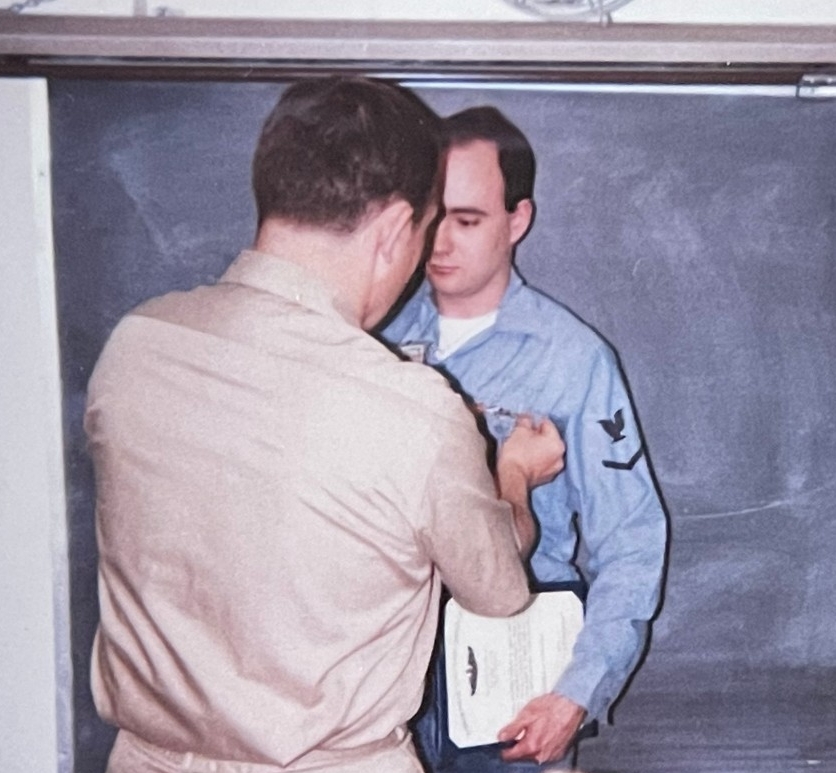
USS Bluefish's (SSN-675) executive officer pins dolphins on MM3 Shawn Vreeland on 6 June 1988 at Portsmouth Naval Shipyard. Bluefish was in dry dock undergoing an overhaul and a reactor refueling at the time. (Photo contributed by Shawn Vreeland)
In 2010, the Navy lifted the ban barring women from serving on submarines. In June 2012, Lieutenant Britta Christianson, Gold Crew supply officer for the guided-missile submarine Ohio (SSGN-726), earned her submarine supply corps dolphins, making her the first female supply corps officer to qualify in submarines. In December 2012, the first three female unrestricted line officers, Lieutenant (j.g.) Marquette Leveque, Lieutenant (j.g.) Amber Cowan, and Lieutenant (j.g.) Jennifer Noonan, qualified in submarines and were awarded their dolphins.
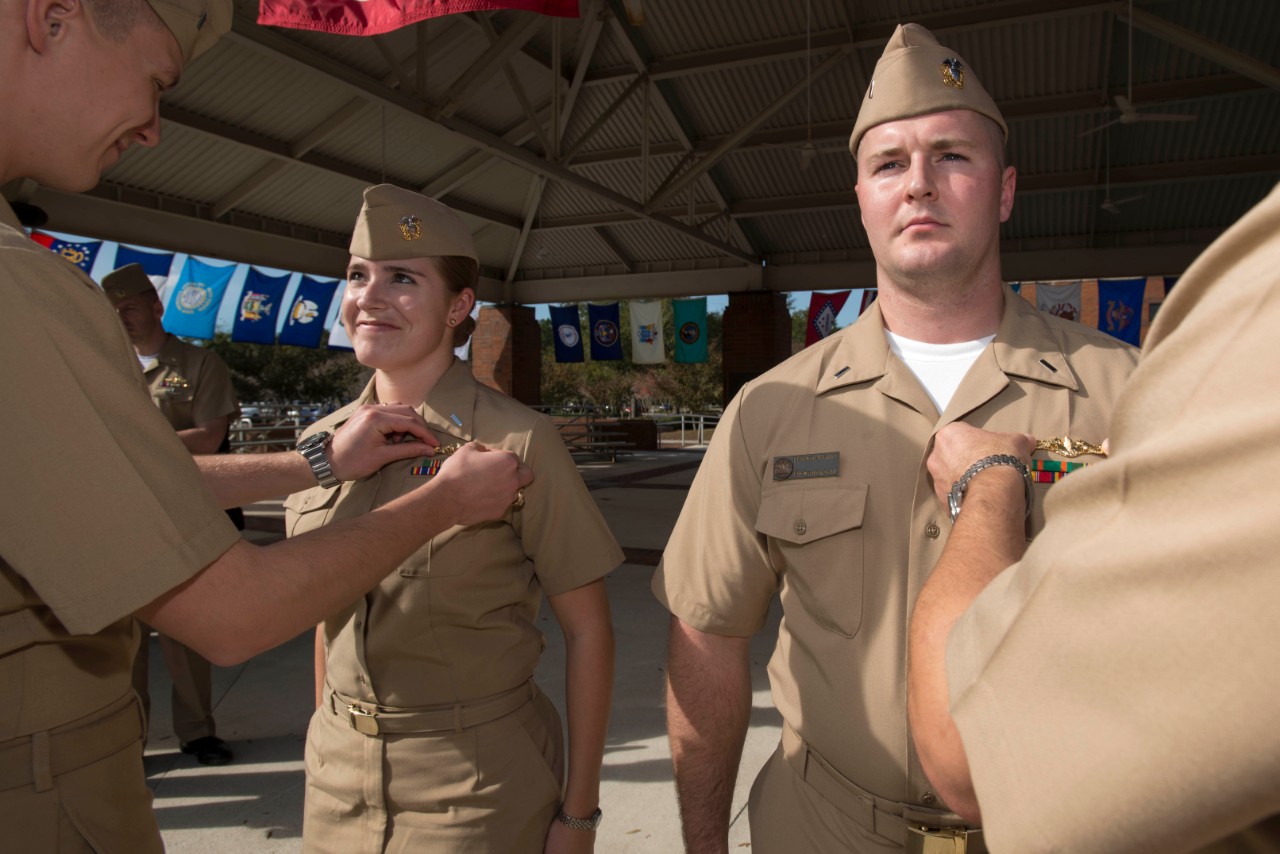
Lt. (j.g.) Marquette Leveque, left, and Lt. (j.g.) Kyle McFadden, both assigned to the Gold crew of the ballistic missile submarine USS Wyoming (SSBN 742), receive their submarine officer warfare devices at Naval Submarine Base Kings Bay. Leveque is one of three sailors to become the first female unrestricted line officers to qualify in submarines. (U.S. Navy photo by Mass Communication Specialist 1st Class James Kimber/Released)
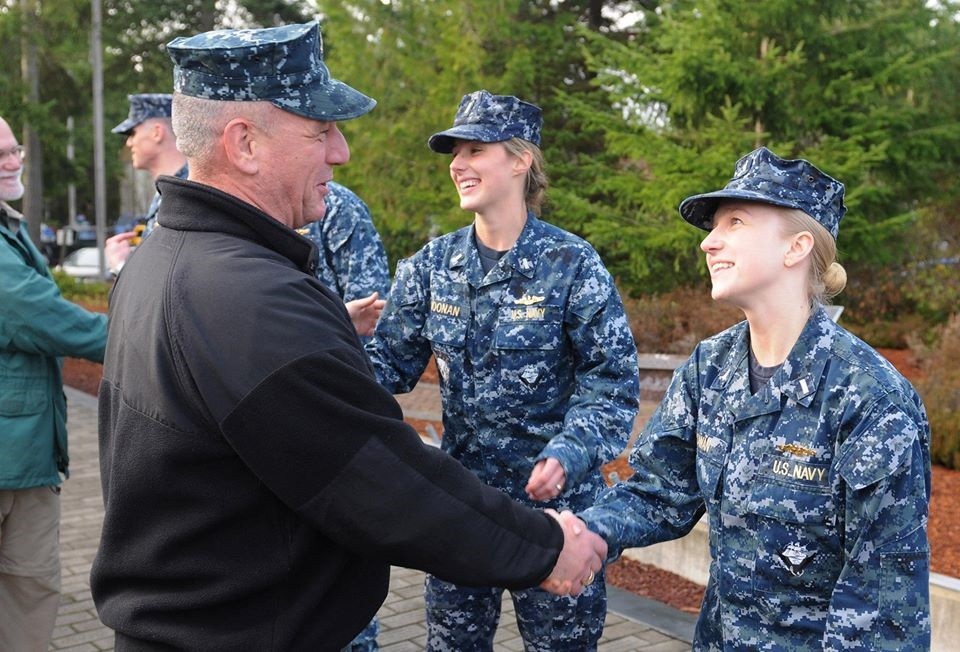
Master Chief Rusty Staub, assigned to Submarine Group 9 Command, congratulates Lt. (j.g.) Amber Cowan, assigned to the Blue crew of the ballistic missile submarine Maine (SSBN-741), for earning her submarine warfare officer device. Cowan and Lt. (j.g.) Jennifer Noonan (center), are two of three sailors to become the first female unrestricted line officers to qualify in submarines. (U.S. Navy photo by Chief Mass Communication Specialist Ahron Arendes)
In 2016, Chief Culinary Specialist Dominique Saavedra became the first female enlisted Sailor to earn her silver dolphins.
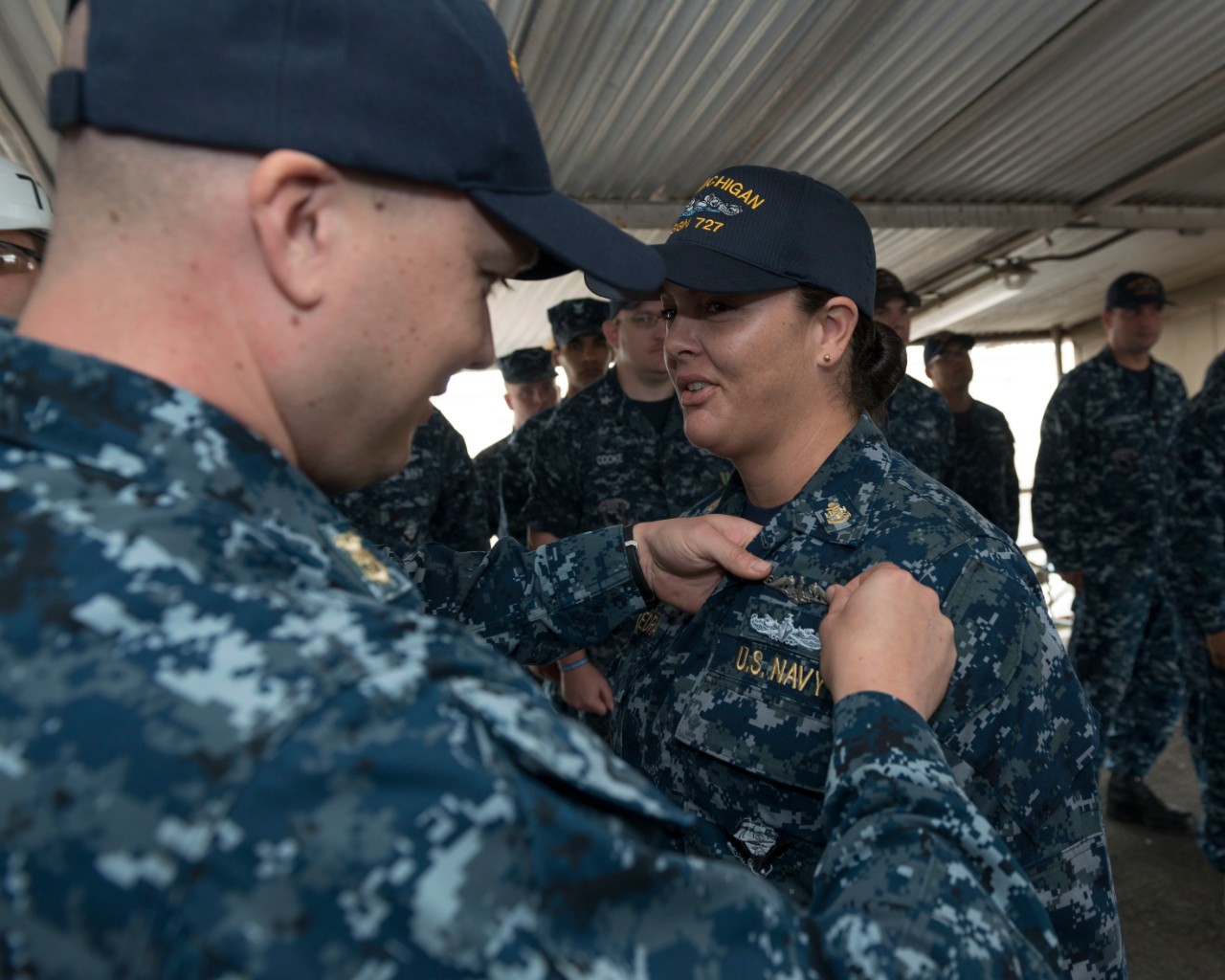
Chief Culinary Specialist Dominique Saavedra, assigned to USS Michigan (SSGN-727) (Blue), is pinned with her enlisted submarine qualification pin during a ceremony at Puget Sound Naval Shipyard on 2 August 2016. Saavedra is the first female enlisted sailor to earn the "dolphins." She qualified aboard USS Ohio (SSGN-726) ahead of deploying aboard USS Michigan (SSGN 727). (U.S. Navy photo by Chief Mass Communication Specialist Kenneth G. Takada)
Other Resources:
H-Gram 008-5: Admiral Ernest J. King—Chief of Naval Operations, 1942
Submarine Dolphins - U. S. Naval Undersea Museum
Further Reading:
Borneman, Walter R. The Admirals: Nimitz, Halsey, Leahy, and King—The Five-Star Admirals Who Won the War at Sea. New York: Little Brown and Company, 2012.
Defense Media Activity. Navy Production Division. “Warfare Devices.” In “Owners and Operators Manual,” supplement, All Hands, January 2022.
Department of the Navy. Bureau of Naval Personnel. United States Navy Uniform Regulations, 1951. NAVPERS 15665 (Rev-51). Washington, DC: Bureau of Naval Personnel, 1951.
Department of the Navy. Bureau of Naval Personnel. Naval Military Personnel Manual. MILPERSMAN-1220-040 (CH-63). Washington, DC: Bureau of Personnel, 2018.
Department of the Navy. Bureau of Naval Personnel. Naval Military Personnel Manual, MILPERSMAN 1210-100. Washington, DC: Bureau of Personnel, 2015.
“Dolphin History.” Submarine Force Library and Museum Association (website). Accessed 14 February 2023.
“Submarine Warfare Insignia.” Commander, Submarine Force Atlantic (website). Accessed 21 February 2023. Submarine Warfare Insignia (navy.mil).
Thornton, W. M. Submarine Insignia & Submarine Services of the World. Annapolis, MD: Naval Institute Press, 1997.

